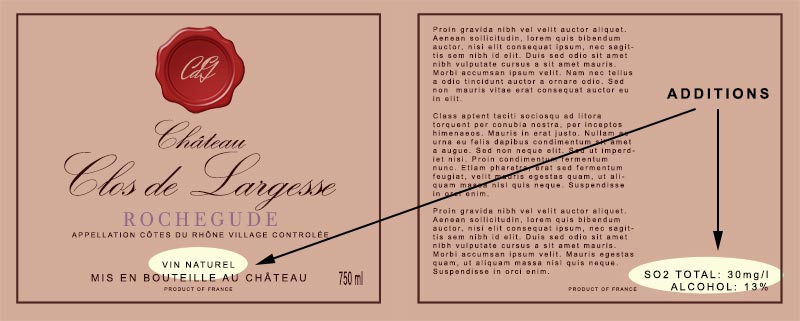Recently, Suzanne Mustacich, contributing editor to Wine Spectator and author of “Thirsty Dragon” wrote a lengthy article that discusses how the French are working to define what “natural wine” is. It’s a noble pursuit which I’m 100% behind for any one of a number of reasons but primarily for the fact that while I usually drink wines that could be considered “natural”, the entire “natural wine” movement is something I can’t stomach as it’s a dogmatic religion more than anything grounded in common sense.
To actually codify what is “natural wine”, is something needed for the general consumer as most people (rightly) don’t really understand it. After all, wine is not something created in a lab, no? All wines are made from grapes and grapes are a naturally occurring food item, right? The “natural” winemakers all preach a core tenet of zero intervention and manipulation but the last I checked, you need to prune grape vines for them to produce wine grapes and you need to pick the grapes at a specific time as they don’t just wander into your cellar on their own. Suffice to say, you don’t go and pluck finished bottles of wine from the vines and there is always, always some degree of intervention and manipulation. This idea of “zero” is an impossibility.
So this opens up the question as to how much can be permitted? This is why a certified labeling for “natural wine” is so needed. For example, a gigantic cooperative in Roussillon can currently slap “natural wine” on anything they produce if they like and no regular wine drinker would know why that would be any different than some tiny little producer up in the Loire Valley who’s plowing everything by mule and sticking a horn of cow shit in the vineyard to dig up six months later.
There is of course blow back from the current “natural” wine producers as it would mean giving full legal status and making extra paperwork for a group that largely tries to avoid such things. Many of them don’t even make wines labelled under their appellations and it’s usually the case the more rebellious they are, the more popular they are in the hardcore natural wine lover crowds.
Creating this certification would be of great benefit to the consumer though as there are many components to it that are quite important and form the base for the vast majority of wines I personally enjoy. So, let’s take a look at what are usually considered to be the Four Pillars of Natural Wine and how they could possibly apply under a future certification according to the natural wine crowd and then my interpretation:
I – Organic grape growing
This is a given. In all facets of agriculture, we need to move away from petrochemicals and back to older methods of farming. It’s better for our health, the environment, and our future. Given that grapes aren’t washed when coming in to the cellar, whatever you put in the vineyard can and will directly end up in your wine.
Natural Wine Stance: Organic or biodynamic “practices” are fine. Certification isn’t necessary.
My Stance: Bullshit. Fully certified or it’s not organic and it’s not natural wine. Countless natural winemakers feel like it’s a pain to bother with the paperwork and expense. Fine, but don’t blow smoke up my ass about how devoted you are. In my view, these winemakers who can’t be bothered to certify, would be exactly the same people to use non-organic shortcuts when the going gets rough. Thus, only certified organic or biodynamic vineyards.
II – Native Yeasts
Again, another given as over time we’ve been learning that yeasts have a profound effect on flavor and if you’re not using the yeasts inherent on your grapes or in your cellar, in favor of commercial “selected” yeasts, then you’re really creating more of a wine “product” than anything that truly expresses origin. I’ll still happily drink it, but it’s a different type of wine.
Natural Wine Stance: Agreed
My Stance: Agreed as well but with caveats under Section IV
III – Natural Fermentation/No Cellar Intervention
This is essentially just letting those ambient yeasts start fermentation. Sometimes this means that ferments can run too hot or too cold which has a dizzying array of effects on the overall aroma and flavor profile. No micro oxygenation, no temperature control, or other corrections are permitted to alter the final flavor.
Natural Wine Stance: Only doing this and nothing more. No controls, no nothing.
My Stance: By making wine indoors, you are already controlling the temperature and thus manipulating the process. If a fermentation starts to slow, warm it up and if starts to get too hot, cool it down. But regardless, as it’s all based on the native yeasts, it’s still a natural process but I do draw the line at the more manipulative aspects (such a micro oxygenation, enzymes, etc.) as, much like selected yeast, they alter the final product a great deal. Although, a lot of this is indeed done naturally depending on your aging vessel.
IV – No Added SO2
Okay, so here’s where things all go sideways. In the absolute purist mentality of natural wines, you can’t put any sulfur dioxide (SO2) in the wine. What is SO2? Firstly, it’s a regularly occurring substance when wine is created and exists up to 10mg/l–naturally. It’s also a preservative and antioxidant compound that we’ve been using in winemaking forever as it stunts bacterial growth and stops the wine from fermenting again, thus stabilizing it. Please note: Sulfites do not cause headaches
Natural Wine Stance: Zero. Absolutely zero. No intervention. Nothing added.
My Stance: No way. You don’t add it and you get shitty wine. Unpleasant bacteria flourish, potentially changing the wine to vinegar among other problems. Even if that doesn’t happen, the wine can oxidize in the bottle during transportation or any other number of moments. You must have a small amount of SO2 in a finished wine, but not too much. Via many years of studies, a total between 20-60mg/l seems to generally be the optimal amount. Less, the wine can spoil. More and it can be detected and unpleasant.
A “Natural Wine” Label
So, taking all of this in to account, how could a proposed “natural wine” label shape up? As I see, quite simply like the one above where on the front it just states, “Natural Wine” in your language of choice (in this case, I did it in French just for kicks) and then on the back the Total SO2.
Why list the Total SO2? For the simple fact that we’ve needed to do away with “Contains Sulfites” for a very, very long time. All this tells you is that the wine in question has more than 10mg/l of SO2, but all finished wines have sulfites! Under EU regulations, if a red wine, then it has less than 150mg/l total unless organically certified wherein it has 100mg/l. If a white wine, then it has less than 200mg/l total or 150mg/l for organic wines.
So as you can see, this “Contains Sulfites” is really meaningless. It’s like putting “Contains Alcohol” on the label. In the case of a “Natural Wine” certification, it’s quite useful as if it says anything of 10mg/l or less, then the consumer knows it has no sulfites added if that’s what they’re looking for. Those of us who don’t want spoiled wine, can then look for wines in the 20-60mg/l. Those who don’t care can ignore it and continue buying solely on price.
Actually, I would propose this system be implemented for all wines so that people can make an informed purchase based upon what the bottle contains, just as when they look at the alcohol.
Ultimately, this is only my opinion on the matter but it would be great if this came about in France because if one country started it, others would have to follow and eventually we’d have a true “Natural Wine” certification that would form a base to end all the pseudoscience bullshit that people thrust upon the moniker.
More than likely these “rebels” that we have now would go out in search of a new name which appears to be forming around “Raw Wine” although I’m curious how this will work with Legeron’s Raw Wine Fair. But I find this name perfect as I’ve always said that buying what is deemed “natural wine” now is like buying raw meat that you don’t put in the fridge afterwards. Some form of legal codification for such a weighted term has reached a crucial moment and needs action.
You’re reading a free article on Hudin.com.
Please consider subscribing to support independent journalism and get access to regional wine reports as well as insider information on the wine world.


